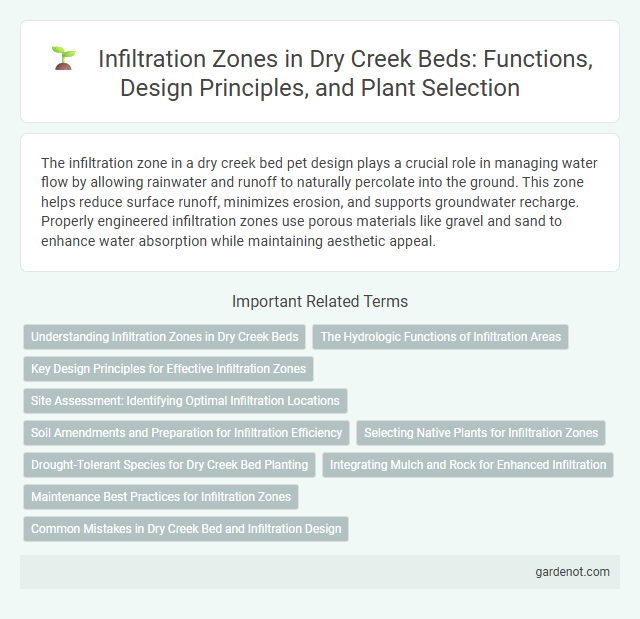The infiltration zone in a dry creek bed pet design plays a crucial role in managing water flow by allowing rainwater and runoff to naturally percolate into the ground. This zone helps reduce surface runoff, minimizes erosion, and supports groundwater recharge. Properly engineered infiltration zones use porous materials like gravel and sand to enhance water absorption while maintaining aesthetic appeal.
Understanding Infiltration Zones in Dry Creek Beds
Infiltration zones in dry creek beds play a critical role in groundwater recharge by allowing surface water to percolate through permeable soil and sediment layers. These zones are characterized by coarse-grained materials like sand and gravel, which enhance water absorption and reduce surface runoff. Identifying and preserving infiltration zones is essential for maintaining hydrological balance and supporting local ecosystems.
The Hydrologic Functions of Infiltration Areas
Infiltration zones within dry creek beds play a critical role in groundwater recharge by facilitating the percolation of surface water into underlying aquifers. These areas enhance soil moisture retention and reduce surface runoff, which mitigates erosion and supports riparian vegetation. Effective infiltration zones contribute to maintaining base flow in streams during dry periods, sustaining aquatic ecosystems and improving overall watershed health.
Key Design Principles for Effective Infiltration Zones
Infiltration zones in dry creek beds are designed to maximize water absorption and recharge groundwater by promoting natural filtration through permeable soils and vegetation. Key design principles include selecting native plants with deep root systems to enhance soil permeability, maintaining appropriate slope gradients to prevent erosion, and incorporating organic matter to improve soil structure. Properly engineered infiltration zones reduce runoff, minimize sediment transport, and support sustainable watershed management.
Site Assessment: Identifying Optimal Infiltration Locations
Site assessment for infiltration zones in dry creek beds involves analyzing soil permeability, topography, and vegetation to identify areas with high infiltration potential. Soil texture and structure directly influence water absorption rates, making sandy or loamy soils ideal for infiltration. Mapping slope gradients ensures runoff is captured efficiently, minimizing erosion and maximizing groundwater recharge in targeted zones.
Soil Amendments and Preparation for Infiltration Efficiency
Soil amendments such as compost, biochar, and sand improve infiltration efficiency in dry creek beds by enhancing soil structure and porosity. Proper preparation includes tilling and loosening compacted soil to facilitate water absorption and reduce runoff. Incorporating organic matter increases microbial activity, further promoting effective water infiltration and retention.
Selecting Native Plants for Infiltration Zones
Selecting native plants for infiltration zones in dry creek beds enhances soil permeability and water absorption, promoting natural filtration and groundwater recharge. Native species such as sedges, rushes, and deep-rooted grasses provide effective erosion control while thriving in fluctuating moisture conditions. Integrating these plants supports local biodiversity and reduces maintenance needs, ensuring long-term sustainability of the infiltration zone.
Drought-Tolerant Species for Dry Creek Bed Planting
Drought-tolerant species such as lavender, sedum, and Russian sage thrive in the infiltration zones of dry creek beds, efficiently absorbing water while reducing soil erosion. These plants possess deep root systems that enhance water retention and promote infiltration in arid conditions. Selecting native drought-tolerant species not only supports local biodiversity but also ensures sustainable water management in dry creek bed landscaping.
Integrating Mulch and Rock for Enhanced Infiltration
In the infiltration zone of a dry creek bed, integrating mulch and rock significantly improves water absorption and soil stabilization. Mulch enhances organic matter content and moisture retention, while rocks reduce surface runoff and prevent erosion by slowing water flow. Combining these materials optimizes infiltration rates, promotes healthier vegetation, and sustains groundwater recharge.
Maintenance Best Practices for Infiltration Zones
Regular inspection and removal of debris in dry creek bed infiltration zones prevent clogging and maintain optimal water absorption rates. Incorporating native vegetation with deep root systems enhances soil permeability and promotes natural filtration processes. Periodic soil aeration and erosion control measures protect the structural integrity of the infiltration zone, ensuring long-term sustainability.
Common Mistakes in Dry Creek Bed and Infiltration Design
Common mistakes in dry creek bed infiltration design include improper grading that hinders water flow and inadequate soil preparation leading to poor infiltration rates. Using non-permeable materials or compacted sediments can limit water absorption, causing pooling or erosion. Failure to account for soil type and local hydrology often results in ineffective stormwater management and increased runoff.
Infiltration zone Infographic

 gardenot.com
gardenot.com